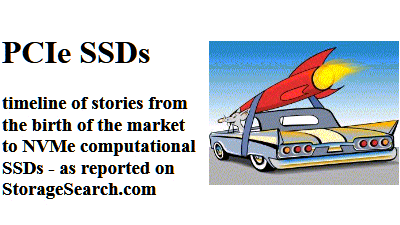Compression-past company
acquired by IBM
Editor:- July 29, 2010 -
Storewiz
announced a
definitive
agreement to be acquired by IBM.
Editor's
comments:- Storewiz's real-time compression technology was
predicated
on a legacy model in which there were no
SSDs (compression-past).
This was a short sighted market view - because SSD IOPS will enable new types of
storage array economics - as discussed in my article
Reaching for the
petabyte SSD (compression-future).
IBM's acquisition may have short
term tactical benefits for the company - and help them collect some patent
license fees but is otherwise irrelevant.
Dataram's revenue up 70% - increases investment in SSD ASAP
Editor:-
July 29, 2010 -
Dataram today
reported
that its annual revenue for the year ended April 30 grew 70% to $44
million incurring a net loss of $1.6 million.
Among other things,
Dataram's president and CEO - John H. Freeman commented on the company's
SSD ASAP.
"The development of our
XcelaSAN product line
continues to progress... In August, we plan to release enhanced features and
functionality which are currently in development to support sales initiatives.
These changes increase the products ease of use, ease of installation and
interoperability.
"High Availability systems are expected to be
available for sale in December. We anticipate that our enhancements and the
shipment of high availability systems will accelerate product sales and broaden
market adoption. We have made and are continuing to make significant
investments in research and development in XcelaSAN. In part, this
investment is being used to develop and implement client recommendations based
on their actual test experiences.
"We will require additional
financial resources to complete development of these enhancements. To that end,
we have entered into an agreement with a financial institution for secured debt
financing of up to $5 million. We have also entered into an agreement with a
vendor to consign up $3 million of certain inventory into our manufacturing
facilities. This will allow us to substantially reduce our inventory carrying
requirements while still maintaining our ability to service our customers. We
expect that these 2 agreements will generate sufficient additional liquidity for
us to meet our operating plans for fiscal 2011."
Fusion-io accelerates 3d movie releases
Editor:- July
28, 2010 - Fusion-io
today
revealed
how it's been helping Hollywood's 3D movie makers.
Fusion-io's SSDs
have been used in the production of:- Alice in Wonderland, Avatar, How to
Train a Dragon and Clash of the Titans.
Utilizing Fusion-io, the S3D conversion of Clash of the Titans took
under 8 weeks instead of typically 6 months using conventional systems.
"Fusion's ioDrives really helped us meet a tough deadline"
said Sean Konrad, Project Manager for Stereoscopic Conversion on this project at
Prime
Focus. "With typical VFX projects, we complete about 20-30 shots per
day. The ioDrives (from
Fusion-io) scaled our data load capabilities by about 20x. Using
Fusion-io drives, each review session covered far more shots and we could
continue cycling work in between sessions. We don't have to worry anymore about
defragmenting disks, rebuilding
RAIDs, or swapping out
disks. We are buying many more ioDrives to implement throughout our different
locations."
how to make "SSD reliability" believable - marketing
case study
Editor:- July 28, 2010 - StorageSearch.com today published
a new article -
the cultivation and
nurturing of "reliability" in a 2.5" SSD brand.
Reliability is an
important factor in many applications which use
SSDs. But can you trust an
SSD brand just because it claims to be reliable?
As we've seen in
recent years - in the rush for the
SSD market bubble -
many design teams which previously had little or no experience of SSDs were
tasked with designing such products - and the result has been successive waves
of flaky SSDs and
SSDs whose specifications
couldn't be relied on to remain stable and in many products quickly
degraded in customer sites.
As part of an education series for SSD
product marketers - this new case study describes how one company - which didn't
have the conventional background to start off with - managed to equate their
brand of SSD with reliability in the minds of designers in the embedded systems
market. ...read
the article
Foremay ships 2TB 3.5" SSDs
Editor:- July 26,
2010 -
Foremay announced it is
shipping 2TB 3.5"
and 1TB 2.5"
SATA flash SSDs in its EC188 M-series model V product range.
R/W
speeds are up to 200MB/s.
ECC is 24-bit.
The SSDs are bootable and support all major operating systems.
Editor's
comments:- BiTMICRO
was the 1st company to announce a terabyte class 3.5" SSD (announced in
November 2007).
But this unit was a non standard height.
pureSilicon was the 1st
company to sample a terabyte
2.5" SSD in a
9.5mm high form factor (in
January 2009).
The
price of these
early TB SSDs meant they were only useful in niche applications. The lower
cost of flash today means that this class of product can be economic in
providing acceleration in legacy server designs - which combine high capacity
and concurrency. Foremay says application examples include - IPTV and VOD
servers.
Fusion-io unties storage software from 30 years of data spin
Editor:-
July 23, 2010 - Fusion-io
recently
released
what it calls a "Virtual Storage Layer" which provides a set of
enhanced programmatic interfaces for optimizing operations which use its
ioMemory family of SSDs.
Editor's comments:- I had a
briefing with Fusion-io's CEO David
Flynn - ostensibly to fill me in on more details about the new software
tools - but as you can imagine - once we started talking about what's happening
in the SSD market - and what we think might happen -
we covered a
wide range of topics - enough for several articles.
Infortrend joins the STEC inside club
Editor:- July
22, 2010 - Infortrend
today
announced
it will use STEC's
ZeusIOPS (SAS SSDs) in
its ESVA F60 product line (FC
RAID systems). |
|
|
| ......................................................................................................................... | |
|
|
| . |
 |
| . |
|
|
| . |
 |
| . |
| The fact that I've only
written this article after more than 10 years writing about SSDs and more than
20 years thinking about them - shows that the need for a symmetry based view of
SSD design has only become apparent after reading about and mentally evaluating
thousands of actual SSDs in all types of markets and being dissatisfied with the
understanding I could convey to my readers by using other ways to describe
aspects of SSD design. |
| how fast can your SSD
run backwards? | | |
. |
 | |






